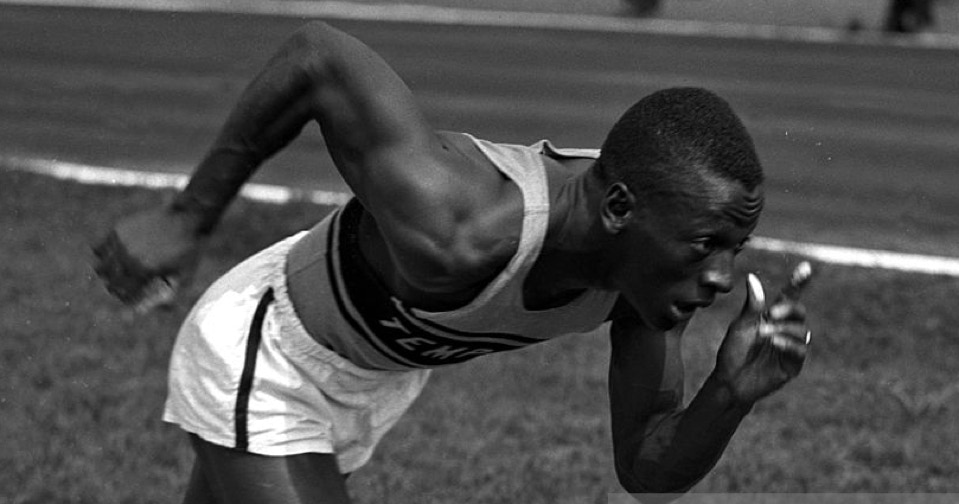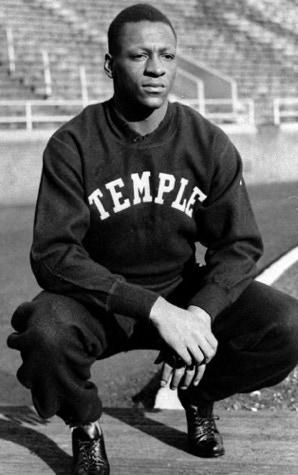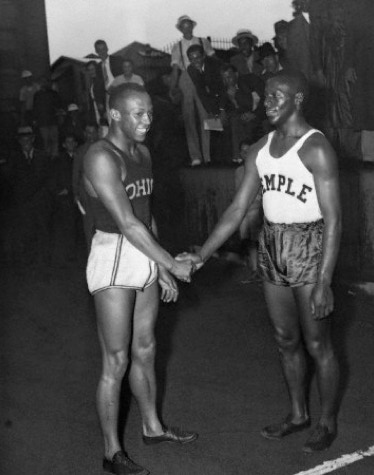BLACK HISTORY'S FORGOTTEN TALENT: Sprinter Eulace Peacock, whose abilities were overshadowed by those of his more famous friend and rival, Jesse Owens. Peacock was faster in the trials for the Berlin Olympics of 1936, but pulled out through injury, leaving Owens to make history.
JULY 11, 1935. In a makeshift stadium on Randall's Island, New York City, two of the fastest men on earth were about to compete for a place in history — specifically, the following summer’s Olympic games in Berlin, Germany. But the omens were not good on that particular day. First, the stadium's loudspeaker system broke down; then a flash thunderstorm spooked both the crowd and the competitors. But for the favourite, an African American sprinter and long jumper named Eulace Peacock, these were small problems. As the New York Times reported at the time, Peacock's right thigh was 'taped up like a baseball bat' — he had sustained a hamstring injury several weeks earlier, and it was still plaguing him. A hamstring is to a sprinter what an accelerator is to a car. Without it, nothing moves. But track officials, eager for him to make it the games, had presented Peacock with two previous opportunities at different track meets, but on both occasions he was hampered by his injury. This was his last chance.
LAST CHANCE FOR OLYMPICS 1936
When Peacock rose from the track and started running, instantly he knew he would not make it. His hamstring — the major muscle that runs along the back of thigh — failed again. He finished tenth in the long jump, and withdrew entirely from the sprints, relinquishing the field to his friendly rival — a man called Jesse Owens. In that moment, a lifetime of training, conditioning, sweat and sacrifice all evaporated. Owens would go on to win Gold at the 1936 Berlin Olympics, make history and become famous, while Peacock instantly became one of history's great sporting “might have beens.”
MODERN OLYMPIC SPRINTING, as epitomized by Usain Bolt, is a very different proposition from what it was in the early 20th century. In those days it was raw talent rather then technique that made winners, whereas today natural ability is augmented with science, biology, nutrition, psychology and vastly improved equipment. While this has lead to the excitement of more world records being broken, it has simultaneously killed the individualism that once characterized some of history's early craftsmen. The 1932 double Olympic champion, African American Eddie Tolan, was a case in point. Nicknamed the "Midnight Express," he was five-foot-seven, with centre-parted Afro hair and circular spectacles that he wore strapped to his head while running. He also liked to chew gum while he sprinted, in sync with each step, which he claimed relieved stress and improved his acceleration.
BLACK PEOPLE SEGREGATED
In early 20th century America, the backdrop against which African American sprinters competed was that of a divided country. The "Jim Crow" laws enacted between 1876 and 1965 mandated the segregation of black from white across public institutions, services and employment, predominantly in the Southern states, but across the North also. African American sportspeople were banned from competing in the major leagues, and all blacks were prohibited from entering restaurants, bars, clubs, hotels and other facilities.
It was within this highly charged atmosphere that Eulace Peacock was born on August 27, 1914 in Dothan, Alabama. His background, upbringing and sporting trajectory were very similar to that of his rival Jesse Owens, who was also born in Alabama, only a year earlier than Peacock. Both sets of parents were sharecroppers who migrated north around the same time, as part of the Great Migration, when 1.5 million African Americans left the segregated South. The Peacocks settled in Union, New Jersey. Eulace attended the local high school, where he excelled as an athlete. He was a gifted long jumper, footballer and pentathlete, for which he became six times National Champion. At the age of 19, he set a New Jersey long jump record of 7.42 meters, which would stand for the next 40 years.
RIVAL JESSE OWENS EXCELS
Meanwhile, over at the National Interscholastic Championships held at Stagg Field, Chicago, Jesse Owens, competing for East Tech High School, went one better, making history by setting new world records in the sprints and the long jump. Despite the fact that he and Eulace Peacock had yet to meet, their rivalry had already begun.
The two athletes had very contrasting sprinting styles. Owens was a "floater" — fleet-footed, with a very upright, almost regal posture and an elegant smoothness across the surface, as if he was running on feathers. Peacock meanwhile, ran as if he was being propelled from behind by a hot blast. His technique relied on strength, power and the channelling of energy through the piston-like kinetics of his arms and shoulders. His style was the more modern of the two runners. He was more muscular than Owens, especially in the legs, more like sprinters are built today. But although Peacock was the more physical sprinter, Owens was the better stylist — arguably the best the sport has ever seen — and modern sprinting has lost something now that it is all about hard charging muscle. These days, everyone runs the same. They are fast, but kinetically less beautiful.
FIRST BLOOD TO PEACOCK
In competition, Eulace Peacock drew first blood on August 6 at a track meet in Oslo, Norway. Aged 19 he equalled the 100-metre world record of 10.3 seconds. This was faster than Jesse Owens had ever run the distance. For a time at least, Peacock was hailed "the world's fastest human." But the focus didn't stay on him for long, because on May 25, 1935 Owens hit world-beating form once again at the Big Ten Championships at Ann Arbor, Michigan. He made history, breaking three world records (for the 220-yard dash, the 220-yard hurdles and the long jump) and equalled another (the 100-yard dash), all in the space of an incredible 45 minutes. Peacock's hopes of being number one had taken a major blow. Owens was not just good, he was world class, and his collective performances were consistently outstanding. With Owens confidence sky high he went on to beat his rival in their next three important track meetings that year. To all concerned, Owens was unbeatable.
But then the unthinkable happened. On July 4, 1935 at the University of Nebraska's Memorial Stadium in Lincoln, Eulace Peacock suddenly found his form again, beating the world record holder in both the long jump and the 100-metres, in a sensational time of 10.2 seconds. It equalled the world record, but was disallowed due to wind assistance. His double victory had gone radically against the formbook. Peacock then pressed home his advantage, beating Owens in their next three sprint encounters.
OWENS DOUBT FOR THE 1936 GAMES
After Owens series of defeats by Peacock, his prospects in the eyes of the experts began to slip. Former Olympic sprint champion Charles Paddock, Owens' childhood idol, came out unequivocally in favour of his rival. "I can only see Peacock as a certain performer at the games in Berlin," he told the LA Times. "I can't help feeling that Owens is pretty much burned out." Paddock's comments stung Owens to the core as they reverberated around the country. With his own confidence beginning to wane, he also started to believe much of the talk about Peacock's superiority. "It's going to take a special man to beat Eulace Peacock," he told Harlem's Amsterdam News. "You see, I've already reached my peak. Peacock is just now reaching his. He's a real athlete. I don't know whether I can defeat him again."
PEACOCK FIRST PULLED his right hamstring while competing in Milan, Italy with the United States track team in August 1935. The Olympic trials were months away, and so there was plenty of time for it to heal. But then disaster struck on April 24, 1936 during a college championship event, the Penn Relays, in Philadelphia. As Peacock ran the anchor leg of the 400 x 100-meters relay, he tore his hamstring again. He later attempted to run on three more occasions, but each time he broke down. His Olympic dream was finally over. His elimination left the field clear for Owens to qualify.
PEACOCK FALLS, JESSE TAKES IT
What happened next is the stuff of legend. Jesse Owens stormed home with four gold medals, winning both sprints, the long jump and the 4 x 100-meters relay, and in the process becoming the most famous sports star in the world. His success, and those of the other 18 African American finalists, opened the way for sports to became — like rap music to a later generation — a means by which blacks could escape poverty and discrimination. At the same time the Berlin finalists shattered the pseudo-science of Hitler's ideal of Aryan racial supremacy.
Ever since the games, sportswriters have argued over the Eulace Peacock "What if?" What events would he have won if he had gone to the Berlin games? Overall, in the build up to the Olympics, Peacock maintained the better stats, beating his rival in five out of their twelve sprint contests, while Owens beat him four times. (On three occasions they were both beaten by other sprinters). Importantly, Peacock's overall times were faster than Owens. So, with all this in Peacock's favour, how many of Owens four gold's would he have claimed? This question is unanswerable, because although Peacock was undoubtedly the man in form, one thing we know for sure from the history of sport, is that anything can happen on the day, and that the in form candidate often doesn't win.
AFTER HISTORY
After Berlin both athletes lead very different lives. Jesse Owens, as champion, was suddenly the most famous man in the world. However, he suffered numerous pressures and humiliations in his attempts to cash in on his success — amongst them having to race against horses, greyhounds and trains. It wasn't until he began doing speaking engagements and commercial endorsements that he became financially secure.
By contrast, Eulace Peacock embarked on a variety of vocations and business ventures, including stints working for the New York City Board of Education and the Internal Revenue Service. In later years he opened a liquor store and a car rental business. He stayed connected with athletics by officiating as a judge at various championship events and Olympic qualifying trials.
PEACOCK'S LEGACY
His final years were marred by Alzheimer's disease. He died in New York City on December 13, 1996. He was 82. Athletics history has recorded him as a kind of "character actor" to Jesse Owens' star turn — a kind of track-and-field version of Willem Defoe, or Philip Seymour Hoffman. Even today, the name Eulace Peacock is almost unknown next to that of his famous friend Jessie Owens. According to Google’s search stats, only 180 people around the world Google Peacock’s name each month, compared to a staggering 90,000 monthly searches for Jesse Owens.
The story of Eulace Peacock's dramatic exit from the greatest athletics competition on earth is enough to strike fear into any would-be Olympian. But there are other important lessons here. For Peacock's tale isn't just about how talent and training can be trumped by sheer bad luck. It is also an important story of true sportsmanship and friendship. For what shape did Peacock's post-running life take? He went into business with the very man who became the legend that he could have been. Admittedly, The Owens and Peacock Company — a wholesale meat-packing operation founded by the two men in the 1960s — might not have been what Peacock had in mind when he battled Owens for track glory back in their heyday, but it was testimony to the camaraderie of the two men that they found a way to continue their double billing.
ABOUT ME
I am a London-based author and publisher. Discover more about me and my latest projects, at Ben Arogundade bio.
ON TRACK: Sprinter Eulace Peacock poses trackside during a break from training: Peacock shakes hands with his friend and rival Jesse Owens, who would go on to win gold at the 1936 Berlin Olympics.
*EULACE PEACOCK & RIVAL JESSE OWENS - ACCORDING TO GOOGLE SEARCH
500
The number of people worldwide who still Google Eulace Peacock’s name, each month.
110,000
The number of people worldwide who still Google rival Jesse Owens’s name, each month.
*All figures for “Eulace Peacock & Rival Jesse Owens - According to Google Search”, supplied by Google. Stats include global totals for laptop and desktop computers and mobile devices.
JESSE OWENS WINS AT THE 1936 OLYMPICS
More About Sports
Does the higher power really takes sides, or do they sit it out?
© Arogundade, London Town 2025: Registered Office: 85 Great Portland Street, First Floor, London W1W 7LT



